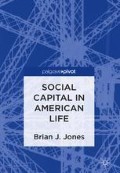Abstract
Recognizing the importance of socializing for public welfare, Jones examines how Americans of different sex, race, and education levels engage with their social networks. Across the decades, American men have averaged more social evenings with friends than American women, and the reverse has been true for visiting with kin. While there is no significant difference between the races in friendship socializing, black Americans visit more with kin than do white Americans. College Americans spend many more social evenings with friends and neighbors than do non-college Americans, but non-college Americans have historically visited kin much more. Overall, Americans are spending more social evenings with friends and fewer with neighbors, while kin socializing dropped in the 1980s and rose to its highest recent level in the 2000s.
Access this chapter
Tax calculation will be finalised at checkout
Purchases are for personal use only
Notes
- 1.
For one very useful compendium, see Bowling Alone, op. cit., Section IV.
- 2.
For the main effect of sex, F = 0.062, p = n.s.; for the main effect of decade, F = 9.246, p < .001.
- 3.
For the main effect of sex, F = 37.537, p < .001; for the main effect of decade, F = 10.593, p < .001.
- 4.
For the main effect of sex, F = 157.657, p < .001; for the main effect of decade, F = 12.540, p < .001.
- 5.
For the main effect of decade, F = 53.250, p < .001; for the interaction effect, F = 2.457, p = .061.
- 6.
For the main effect of decade, F = 11.945, p < .001; for the interaction effect, F = 3.734, p = .011. Happiness is here coded as 1 for respondents saying they are “very happy,” and 0 for “pretty happy” and “not too happy.” The mean scores for the 2000s differ by only .006.
- 7.
For the main effect of age, F = 888.196, p < .001; for the main effect of decade, F = 6.217, p < .001.
- 8.
For the main effect of decade, F = 22.666, p < .001.
- 9.
For the main effect of age, F = 187.303, p < .001; for the main effect of decade, F = 15.372, p < .001.
- 10.
For the main effect of decade, F = 48.775, p < .001; for the main effect of age, F = 163.224, p < .001.
- 11.
For the main effect of age, F = 69.723, p < .001.
- 12.
For the main effect of decade, F = 12.633, p < .001; for the interaction effect, F = 2.795, p = .010.
- 13.
For the main effect of race, F = 32.844, p < .001. The F-value in Fig. 5.9 was 30.280.
- 14.
For the main effect of race, F = 2.070, p = n.s.; for the main effect of decade, F = 7.018, p < .001.
- 15.
For the main effect of race, F = 86.649, p < .001; for the main effect of decade, F = 7.269, p < .001.
- 16.
For the main effect of race, F = 15.555, p < .001; for the main effect of decade, F = 31.278, p < .001; for the interaction effect, F = 2.421, p = .064.
- 17.
For the main effect of race, F = 329.513, p < .001; for the interaction effect, F = 6.972, p < .001. The number of black Americans saying that are “very happy” rose 4% from the 1990 to the 2000s.
- 18.
For the main effect of education, F = 77.925, p < .001; for the main effect of decade, F = 13.462, p < .001.
- 19.
The mean for college Americans always exceeds 3 = monthly, and the mean for non-college Americans never reaches 3.0.
- 20.
For the main effect of education, F = 593.940, p < .001; for the main effect of decade, F = 0.997, p = n.s.
- 21.
For the main effect of education, F = 123.191, p < .001; for the interaction effect, F = 8.201, p < .001.
- 22.
For the main effect of education, F = 25.166, p < .001; for the main effect of decade, F = 62.468, p < .001.
- 23.
For the main effect of decade, F = 18.929, p < .001; for the main effect of education, F = 122.242, p < .001; for the interaction effect, F = 6.637, p < .001.
- 24.
“Unprecedented” is no exaggeration. The increase in the mean value of Total Socializing over 2000–2002 is greater than that for any other contiguous set of years.
- 25.
Christopher A. Bail, “The Fringe Effect: Civil Society Organizations and the Evolution of Media Discourse about Islam since the September 11th Attacks,” American Sociological Review (December 2012), 857.
Reference
Bail, Christopher A. “The Fringe Effect: Civil Society Organizations and the Evolution of Media Discourse about Islam since the September 11th Attacks,” American Sociological Review (December 2012).
Author information
Authors and Affiliations
Rights and permissions
Copyright information
© 2019 The Author(s)
About this chapter
Cite this chapter
Jones, B.J. (2019). Social Networks and Happiness. In: Social Capital in American Life. Palgrave Pivot, Cham. https://doi.org/10.1007/978-3-319-91180-9_6
Download citation
DOI: https://doi.org/10.1007/978-3-319-91180-9_6
Published:
Publisher Name: Palgrave Pivot, Cham
Print ISBN: 978-3-319-91179-3
Online ISBN: 978-3-319-91180-9
eBook Packages: Social SciencesSocial Sciences (R0)

